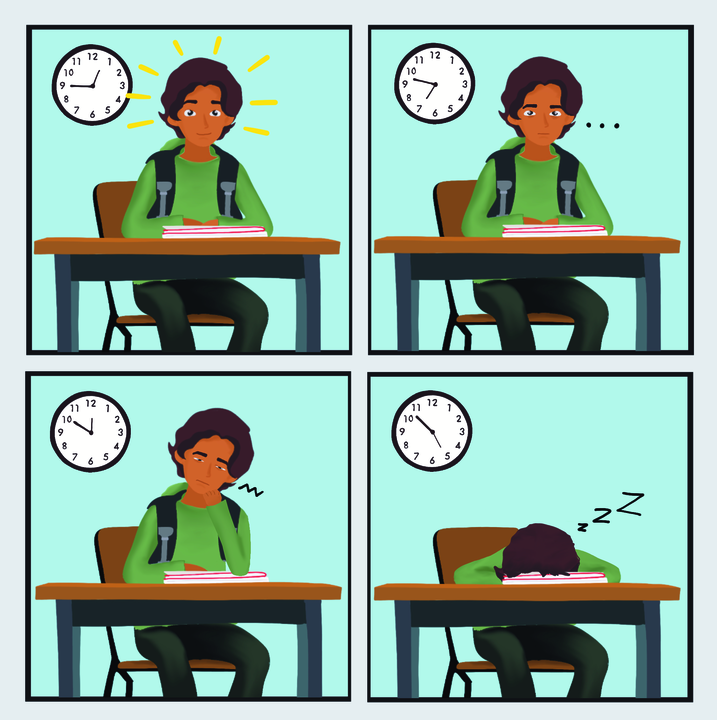You wake up to a 6:30 alarm and make a 7:50 a.m. bell for zero period PE, followed by a full day of four, 90-minute lectures, sports practice or rehearsal after school and the tail end of production for journalism class or debate practice. Though it seems ridiculous, this is a far too common experience among students.
Although some might argue students inflict this chaos on themselves by taking on multiple extracurricular activities and rigorous classes, it has become part of the school culture, ultimately taking a large toll on student mental health. PAUSD’s existing class schedule only exacerbates the stresses of exhausted students.
Under California law, high school students are required to spend 180 instructional days and 1080 hours in school every year. This breaks down to six hours per day on average, excluding lunch. California further prohibits high schools from starting before 8:30 a.m.
Unfortunately state law is flawed when it comes to educational requirements and only creates more student stress. There is no federal law regarding the hours per year that a high school student must attend school requirements vary greatly. According to Pew Research Center, state requirements range from 720 hours in Arizona to 1260 hours in Texas. If the number of hours were actually crucial wouldn’t they be more strictly regulated? Having scientifically proven and regulated hours would reduce stress for students.
The current schedule is flawed for several reasons. First, 90-minute periods are too long. Ontario Tech University reported that most high school classes across the nation are an hour long, and even college lectures have become shorter. According to the National Library of Medicine, teenage attention spans are as brief as 15 minutes. As a result, many students tend to zone out, get fatigued or stop focusing after about an hour at maximum.
On the other hand, Monday’s short 45, and even 35, minute classes are often too fast-paced for students to keep up. In my experience, teachers tend to cram in material on Mondays that can go over students’ heads without proper explanation or time for understanding. And having to switch through all seven subjects in one day can be exhausting, confusing, and difficult to retain anything teachers say.
The worst part about the schedule, though, seems to be that its potential benefits are not being used. When the current 90-minute classes replaced Paly’s previous one-hour classes in 2013, proponents argued the additional 30 minutes per class would be allocated for homework completion. Parents said students were receiving too much homework, so the schedule proposal aimed to minimize, if not eliminate, homework for all classes.
Homework is not supposed to be due on Mondays to prevent students from having to cram in seven assignments on Sunday night. Quizzes, tests and other summative assignments are also not supposed to be administered that day. While some classes follow this rule, many teachers seem to have forgotten or disregarded this guideline.
So even if changing the current schedule isn’t possible, administrators should enforce the original guidelines prohibiting homework deadlines on Monday and providing more time to complete homework during block periods. This would at least make the block schedule classes more manageable for students.
However, this practice has not been implemented effectively as most teachers spend the entire 90 minutes lecturing while also assigning additional homework. The district has repeatedly administered surveys during PRIME in an effort to gather student feedback about the schedule, but no visible changes have been made.
Additionally, all classes should provide a seven to 10 minute break halfway through all periods for students to mentally regroup. Students who need breaks are reluctant to take them since they are afraid to miss class material. This is especially crucial with the new attendance system since only two students are allowed out of class at a time. However, if breaks were mandatory and built into class time, students would be able to focus better and not have to worry about missing class.
Also, there is no need for Monday to include all seven classes — the state requires three hours per week of instruction for a class to be considered a course, which the block schedule already provides. Instead, Monday’s could include four primes and an extended lunch. This would also be more useful than the current setup for students who need to check in with multiple teachers or classes regarding individual questions and allow students to seek more one-on-one help with class material. This solution would even meet requirements, because the six instructional hours a day and the three hours of required instructional time per course would remain fulfilled.
Even just one hour less of school each day would prevent a dark, 4:10 p.m. dismissal when it is nearly dark outside during winter. Ideally, PRIME, study hall and advisories should also be made optional. A better approach would be to have an open office-hours system for teachers during PRIME. This way, students could go home or prepare for practice if they need to while others still have the option to check in with teachers. Students could also study in the library, which is often a more convenient and focused environment. Instead of being bound to one teacher for the entire period, they could visit multiple rooms to get help in various courses.
While some of these changes are ambitious and would require changing state law, I think our community and district can still make small changes for the benefit of both students and staff. It’s time to design a schedule that benefits those who have to withstand it every day.


